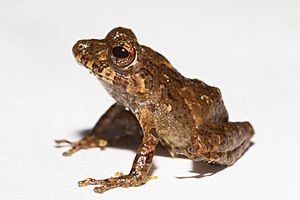Pristimantis cruentus facts for kids
Quick facts for kids Pristimantis cruentus |
|
|---|---|
 |
|
| Conservation status | |
| Scientific classification | |
| Synonyms | |
|
The Chiriqui robber frog (scientific name: Pristimantis cruentus) is a type of frog. It belongs to a family of frogs called Strabomantidae. These frogs are often found in Central and South America.
This special frog lives in Costa Rica, Panama, and the northwestern part of Colombia. It likes to make its home in forests. This includes both wet forests in lowlands and forests high up in the mountains. You might even find it in places where forests have been changed by people. Sadly, this frog is facing a threat because its natural home is disappearing.
Contents
About the Chiriqui Robber Frog
The Chiriqui robber frog is a small amphibian. Like all frogs, it starts its life as a tadpole. But unlike many frogs, the eggs of Pristimantis cruentus hatch directly into tiny froglets. This means they skip the tadpole stage that lives in water. This special way of growing helps them live in places without ponds or streams.
What Does It Look Like?
Most frogs in the Pristimantis group are small. They usually have bumpy skin and come in different shades of brown, green, or gray. These colors help them blend in with their surroundings. This is called camouflage. It helps them hide from predators and sneak up on their prey.
Why Is It Called a Robber Frog?
The name "robber frog" might sound a bit strange. It comes from the way some frogs in this group make calls. Their calls can sound like a "robber" or a "thief" noise. This is how male frogs attract females during the breeding season. Each species has its own unique call. This helps them find a mate of the same kind.
Where Does the Chiriqui Robber Frog Live?
This frog is found in a specific part of the world. It lives in the warm, humid regions of Central and South America. Its main homes are in Costa Rica, Panama, and Colombia.
Its Natural Habitat
The Chiriqui robber frog prefers forests. It lives in both lowland forests, which are close to sea level, and montane forests, which are higher up in the mountains. These forests are usually very wet and full of plants. This provides lots of places for the frogs to hide and find food.
Forest Homes
In these forests, the frogs can be found on the forest floor. They might hide under leaves, logs, or rocks. They also climb on plants and small trees. The damp environment is perfect for their skin. Frogs breathe partly through their skin, so it needs to stay moist.
Living in Changed Areas
Sometimes, this frog can also be found in "degraded habitats." This means places where the forest has been partly cut down or changed by humans. This shows that the Chiriqui robber frog can adapt a little. However, it still needs forest areas to survive and thrive.
Protecting the Chiriqui Robber Frog
Like many animals around the world, the Chiriqui robber frog is facing challenges. The biggest threat to this frog is habitat loss.
What Is Habitat Loss?
Habitat loss happens when the natural places where animals live are destroyed or changed. For the Chiriqui robber frog, this means forests are being cut down. This can be for farming, building new towns, or other human activities. When forests disappear, the frogs lose their homes, their food sources, and places to lay their eggs.
Why Is It Important to Protect Frogs?
Frogs are an important part of the ecosystem. They eat insects, which helps control insect populations. They also serve as food for other animals, like birds and snakes. When frog populations decline, it can affect the entire food web. Protecting frogs helps keep the natural world healthy and balanced.
See also
 In Spanish: Pristimantis cruentus para niños
In Spanish: Pristimantis cruentus para niños


